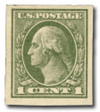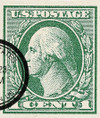
1919 1c Washington, imperforate, gray green
# 531 - 1919 1c Washington, imperforate, gray green
$18.50 - $190.00
U.S. #531
1918-20 1¢ Washington
1918-20 1¢ Washington
Issue Date: January 1919
Printed by: Bureau of Engraving and Printing
Method: Offset printing
Watermark: None
Perforation: None
Color: Gray green
The imperforate Series of 1918-20 1¢ Washington stamp was issued for use by private coil manufacturers. The only company still active at the time was Mail-O-Meter, which had evolved from the Schermack Company (and still used their vending machines).
Offset Printing
The Bureau of Engraving and Printing experimented with a printing method known as “offset printing” to increase production and save money. Photographs of a die proof used for flat plate and rotary stamps were enlarged and “re-touched” to make the details clearer. A photo negative of the altered image was then shrunk back to normal size and placed on a sensitized plate, one after the other. Next, an entire “mask” (image) of the plate was used to create the offset plates.
This allowed the bureau to create plates of much greater size than possible with the engraved method. Plates contained 400, 800, or 1600 stamp subjects.
Identifying Offset Printed Stamps
The ink on offset printed stamps feels smooth and flat. Stamps made by an engraved flat plate or rotary press have a textured feel, due to the raised ink on the surface. Offset printed stamps also often have poor-quality images. They typically don’t have as distinct detail as engraved stamps. Double-printed stamps were also relatively common. Sometimes sheets were so lightly printed they were run through again to save paper.
Offset Series of 1918-20
With the introduction of offset printing, the Bureau began its first experiment in mass production. Although millions of stamps were being printed each day with the conventional flat bed presses, this new method allowed for the printing plates to be produced automatically. Therefore, the plates could be prepared containing as many as 1600 stamps as compared to the old plates, which only had 400 per plate! These were the largest plates ever produced.
The process for making offset plates was basically performed with a camera and required no engraving or transfer rolls. An enlarged photograph of an engraved die proof was retouched to emphasize the shading lines and then photographed to create the “master negative.” This negative was placed in a special repeat machine, which photographically reproduced the positive impression on a glass plate. The image was repeated until the desired number of stamps was positioned on the plate.
From this glass plate, a celluloid negative, called a “mask,” was created, and at this stage, the plate numbers and guidelines were added. Finally, a positive impression was made on a steel plate, which was the actual plate used in printing.
Several differences distinguish stamps printed by offset from a flat plate stamp. The most noticeable is the lack of texture if one runs a finger lightly across the stamp’s surface. Because the ink lies flat on the paper, an offset stamp will feel very smooth, while the flat plate stamp, that is engraved, will have tiny grooves and ridges. Also, the ink used in offset printing is of a different quality and will vary in color when compared to the flat plate stamps. All stamps printed by the offset process will appear blurry and have less-defined images.
U.S. #531
1918-20 1¢ Washington
1918-20 1¢ Washington
Issue Date: January 1919
Printed by: Bureau of Engraving and Printing
Method: Offset printing
Watermark: None
Perforation: None
Color: Gray green
The imperforate Series of 1918-20 1¢ Washington stamp was issued for use by private coil manufacturers. The only company still active at the time was Mail-O-Meter, which had evolved from the Schermack Company (and still used their vending machines).
Offset Printing
The Bureau of Engraving and Printing experimented with a printing method known as “offset printing” to increase production and save money. Photographs of a die proof used for flat plate and rotary stamps were enlarged and “re-touched” to make the details clearer. A photo negative of the altered image was then shrunk back to normal size and placed on a sensitized plate, one after the other. Next, an entire “mask” (image) of the plate was used to create the offset plates.
This allowed the bureau to create plates of much greater size than possible with the engraved method. Plates contained 400, 800, or 1600 stamp subjects.
Identifying Offset Printed Stamps
The ink on offset printed stamps feels smooth and flat. Stamps made by an engraved flat plate or rotary press have a textured feel, due to the raised ink on the surface. Offset printed stamps also often have poor-quality images. They typically don’t have as distinct detail as engraved stamps. Double-printed stamps were also relatively common. Sometimes sheets were so lightly printed they were run through again to save paper.
Offset Series of 1918-20
With the introduction of offset printing, the Bureau began its first experiment in mass production. Although millions of stamps were being printed each day with the conventional flat bed presses, this new method allowed for the printing plates to be produced automatically. Therefore, the plates could be prepared containing as many as 1600 stamps as compared to the old plates, which only had 400 per plate! These were the largest plates ever produced.
The process for making offset plates was basically performed with a camera and required no engraving or transfer rolls. An enlarged photograph of an engraved die proof was retouched to emphasize the shading lines and then photographed to create the “master negative.” This negative was placed in a special repeat machine, which photographically reproduced the positive impression on a glass plate. The image was repeated until the desired number of stamps was positioned on the plate.
From this glass plate, a celluloid negative, called a “mask,” was created, and at this stage, the plate numbers and guidelines were added. Finally, a positive impression was made on a steel plate, which was the actual plate used in printing.
Several differences distinguish stamps printed by offset from a flat plate stamp. The most noticeable is the lack of texture if one runs a finger lightly across the stamp’s surface. Because the ink lies flat on the paper, an offset stamp will feel very smooth, while the flat plate stamp, that is engraved, will have tiny grooves and ridges. Also, the ink used in offset printing is of a different quality and will vary in color when compared to the flat plate stamps. All stamps printed by the offset process will appear blurry and have less-defined images.













